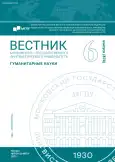Модальные значения немецкого глагола können и русского мочь в различных типах контекстов
- Авторы: Аверина А.В.1,2
-
Учреждения:
- Московский государственный областной педагогический университет
- Московский государственный лингвистический университет
- Выпуск: № 6(874) (2023)
- Страницы: 9-17
- Раздел: Языкознание
- URL: https://journal-vniispk.ru/2542-2197/article/view/350883
- ID: 350883
Цитировать
Полный текст
Аннотация
В статье получают описание контекстуальные условия, влияющие на интерпретацию модальных значений глагола мочь в русском и können в немецком языке. Посредством использования метода контекстуального анализа, описательного и трансформационного методов показано, что на переходность модальных значений оказывают влияние такие параметры, как активность / пассивность семантического субъекта, вид глагола, временная перспектива и использование соответствующих лексических показателей.
Ключевые слова
Об авторах
Анна Викторовна Аверина
Московский государственный областной педагогический университет; Московский государственный лингвистический университет
Автор, ответственный за переписку.
Email: Anna.averina@list.ru
доктор филологических наук, профессор, профессор кафедры германской филологии Московского государственного областного педагогического университета; профессор кафедры грамматики и истории немецкого языка факультета немецкого языка Московского государственного лингвистического университета
РоссияСписок литературы
- Козинцева Н. А. К вопросу о категории засвидетельствованности в русском языке: косвенный источник информации // Проблемы функциональной грамматики. Категории морфологии и синтаксиса в высказывании. СПб.: Наука, 2000. С. 226–240.
- Socka A. Satzadverbien und Modalverben als Marker der Reportativität im Deutschen und im Polnischen. Reihe: Danziger Beiträge zur Germanistik. Bd. 60, 2021.
- Abraham W. Deutsche Syntax im Sprachenvergleich. Grundlegung einer typologischen Syntax im Deutschen. Tübingen: Stauffenburg Verlag, 2013.
- Diewald G. Deixis und Textsorten im Deutschen. Tübingen: Max Niemeyer Verlag, 1991.
- Diewald G. Die Modalverben im Deutschen. Grammatikalisierung und Polifunktionalität. Tübingen: Niemeyer Verlag, 1999.
- Diewald G. Modus und Modalverben – Kategorisierungsoptionen im grammatischen Kernbereich der Modalität // Funktionen der Modalität. Berlin ; Boston: De Gruyter, 2013. S. 77–110.
- Kотин М. Л. Язык и время. Очерк теории языковых изменений. М.: Издат. дом ЯСК, 2018.
- Kotin M. L. Der deutsche Dativ genealogisch und diachron. Eine Sprachwandelstudie über den dritten Fall // Beiträge zur Geschichte der deutschen Sprache und Literatur. Bd. 143 Heft 1, 2021. S. 51–111.
- Аверина А. В. Семантика безличных конструкций с дательным субъекта состояния в немецком и русском языках // Филологические науки. Вопросы теории и практики. 2022. Т. 15. №2. С. 569–575.
- Leiss E. The silent and aspect-driven patterns of deonticity and epistemicity: A chapter in diachronich typology // Modality-aspect Interfaces. Implications and typological solutions, 2008. P. 15–42.
- Булыгина Т. В., Шмелев А. Д. Языковая концептуализация мира (на материале русской грамматики). М.: Языки русской культуры, 1997.
- Kotin M. L. Modalitäten // Zeitschrift des Verbandes polnischer Germanisten. Wydawnitwo Uniwersytetu Jagiellonskiego: Jagiellonian University Press, 2012. S. 140–158.
- Крысько В. Г. Этнопсихологический словарь. М.: МПСИ, 1999.
- Hundt M. Epistemische Modalität im Deutschen // Zeitschrift für germanistische Linguistik. 2003. # 31, S. 343–381.
- Averina A. Nebensätze des Deutschen und des Russischen aus der Sicht ihrer Modalisierung: Tiefenstruktur und Semantik // Sprachwissenschaft. 2020. Bd. 45. №4. S. 425–471.
Дополнительные файлы











